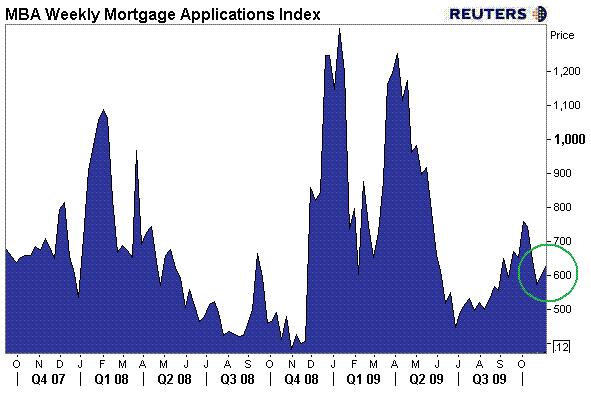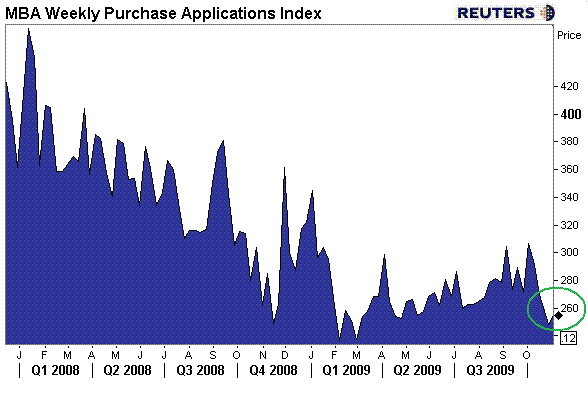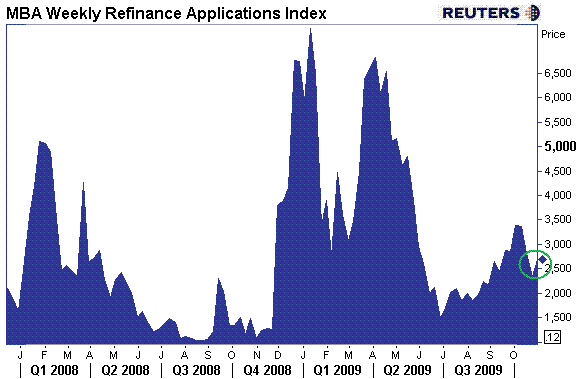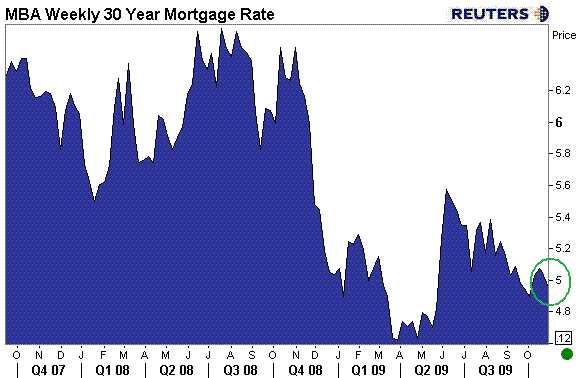Blog

Mortgage Applications Increase 8.2%. Refinance Demand Up 14.5%
The Mortgage Bankers Association today released the Weekly Survey on Mortgage Application Activity for the week ending October 30, 2009.
Housingrnis a key component of economic forecasts, thus real estate surveys andrnhousing data are closely scrutinized by policy makers.
ThernMortgage Banker's application survey covers over 50% of all USrnresidential mortgage loan applications taken by mortgage bankers,rncommercial banks, and thrifts. The data gives economists a look intornconsumer demand for mortgage loans. A rising trend of mortgagernapplications indicates home buying interest is increasing, a positivernfor the housing industry and economy as a whole. Furthermore, in a lowrnmortgage rate environment, a trend of increased refinance applicationsrnimplies consumers are seeking out a lower monthly payments which canrnresult in increased disposable income and therefore more money to spendrnon discretionary items…or just an opportunity to pay down other debtsrnlike credit cards and car loans.
In last week's release, which reported data for the week endingrnOctober 23, mortgage application activity fell 12.3% even as mortgage rates dropped from 5.07% to 5.04%. The Refinance Index, decreased 16.2% from the previous week while thernseasonally adjusted Purchase Index moved lower as well, decreasing 5.2%rnfrom one week earlier. The refinance share of mortgage activity fell torn62.3% of total applications from 65.0% in the previous week.
In today's release, which covers new loan applications for the weekrnending October 30, the MBA reported that demand for new mortgages increased 8.2% and the average 30 year fixed mortgage rates fell from 5.04% to 4.97%.
From the Mortgage Banker's Association…
The Market Composite Index, a measure of mortgage loan application volume, increased 8.2% on a seasonally adjusted basis from one week earlier. The four week moving average for the seasonally adjusted Market Index is down 5.5%.

The seasonally adjusted Purchase Index decreased 1.8% from one week earlier. The four week moving average is down 5.0% for the seasonally adjusted Purchase Index

The Refinance Index increased 14.5% from the previous week. The four week moving average is down 5.7% for the Refinance Index. The refinance share of mortgage activity increased to 66.1% of total applications from 62.3% the previous week.

The average contract interest rate for 30-year fixed-rate mortgages decreased to 4.97 percent from 5.04 percent, with points decreasing to 1.01 from 1.25 (including the origination fee) for 80 percent loan-to-value (LTV) ratio loans. The average contract interest rate for 15-year fixed-rate mortgages decreased to 4.33 percent from 4.53 percent, with points increasing to 1.33 from 0.78 (including the origination fee) for 80 percent LTV loans. The average contract interest rate for one-year ARMs increased to 6.83 percent from 6.79 percent, with points increasing to 0.31 from 0.29 (including the origination fee) for 80 percent LTV loans.

Survey results for the week ending November 6th will be released on Thursday, November 12th due to the Veterans' Day holiday on Wednesday, November 11th.
All Content Copyright © 2003 – 2009 Brown House Media, Inc. All Rights Reserved.nReproduction in any form without permission of MortgageNewsDaily.com is prohibited.
Latest Articles
By John Gittelsohn August 24, 2020, 4:00 AM PDT Some of the largest real estate investors are walking away from Read More...
Late-Stage Delinquencies are SurgingAug 21 2020, 11:59AM Like the report from Black Knight earlier today, the second quarter National Delinquency Survey from the Read More...
Published by the Federal Reserve Bank of San FranciscoIt was recently published by the Federal Reserve Bank of San Francisco, which is about as official as you can Read More...

Comments
Leave a Comment